Jeff Bezos: “Going to Space for the Good of the Earth”
This is the best video I watched in 2019. It is a pity that I did not watch it in May, but only now, when the translation into Russian came out.
In the first part, Jeff Bezos talks about his childhood dreams about space and about his way of thinking about the future (a planning horizon of more than 200 years, energy depletion, starting small, doing things not for immediate benefits, but for the future, projects for several generations ahead, etc. ), in the second part - about his lunar project. In the end, Jeff passes the baton to the younger generation. Enjoy watching.
Decoding:
20 seconds to start.
15 seconds to start.
Transition to autonomous control.
Twelve.
Eleven.
Ten.
Nine.
I start the ignition.
Six.
Five.
Four.
Three.
Two.
One.
Zero.
All engines are working in order.
Climb.
Rise of Apollo 11.
The service tower is normal.
Neil Armstrong reports from the Sea of Peace.
We will read the plate that is on the landing gear support. Hemispheres come first, each showing the hemisphere of the Earth. It is written below: “Here Man from planet Earth first set foot on the moon, July 1969 A.D. We have come in peace for all of humanity. ”
Oh cool. Is lighting half decent?
Good, they also got a flag, and now on the surface of the moon you can see stars and stripes.
Wow!
If this does not inspire you, you have come here in vain. You do not choose a dream. This dream is choosing you. When I was 5, I saw what you just watched. And it had a huge impact on me, which has not changed over time.
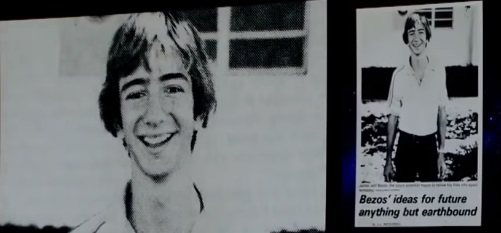
This is me in high school. And I want to pay attention to this quote.

“Earth is not infinite, and if the world economy and population continues to grow, then space will remain the only way for movement.”
I still believe in it. By the way, this is my version of wasted youth. Guess which planet is the best in the solar system? This question is easy to answer. We launched research vehicles, such as this one, to all corners of the solar system. Some of them just flew past the planets, but examined them all. Earth is the best planet. It is not close. She is really good. Don't even start talking about Venus. Look at the earth. She is incredible. Jim Lovell, one of my heroes. During the Apollo 8 mission, when he circled the moon, he did something amazing.

He raised his thumb, and realized that with his thumb he could close the whole Earth. All that he knew could be covered with a finger and he said something amazing. “People often say,“ I hope to go to heaven after death. ” He said, "At that moment, I realized that I went to heaven when I was born." Earth is heaven.

Karl Sagan, spoke poetically. “At this blue dot, everything you have ever known, and everything you've ever heard of. And all the people who have ever lived have lived their lives here. This is a very small platform in a vast space arena. ”
Throughout the history of mankind, the Earth has been felt more than us. And in fact, this is a pretty true feeling. She must be big. Humanity must be small. But the reality is now different. The earth has ceased to be big. Humanity has become too great.
The planet seems big, but it is not infinite. And there is something we need to do. It is necessary to realize that there are urgent problems; things to work on and we are working on them. We are talking about poverty, hunger, the homeless, the environment, the depletion of the ocean. There is a large list of problems of urgent problems and we need to work on these things urgently, here and now.
But, there are also long-term problems. And you need to work on them too. And their decision will take more time. You cannot wait for long-term problems to become urgent. We can do both. We can work here and now and we can work on solving long-term problems.
The main long-term problem is the energy depletion of the Earth. Even purely arithmetic - it will happen.

As an animal, a person consumes 97 watts of energy. This is our metabolism as a biological being.

But as residents of the civilized world, we consume 10,000 watts per person. And we have a lot of benefit from this. We live in an era of dynamic growth. Your grandparents have better living conditions. And they lived better than their grandparents. And a significant reason for this is the abundance of energy that we are able to receive and use with benefit.
When we use energy, a lot of good things happen. When you are in the hospital, we use a lot of energy. All medical equipment was created for you at the enterprises. Transport. Different types of entertainment that bring us joy. The medicines that we use. All these things require a large amount of energy, which we do not stop using. But this thing is unstable. Here is what we have.

The rate of energy consumption in human history is growing at 3 percent every year. 3% does not sound very impressive. But over a long time span, 3% show extreme growth. This means doubling energy needs every 25 years. For example, to cover today's energy needs of humanity, it is enough for us to cover the state of Nevada with solar panels.
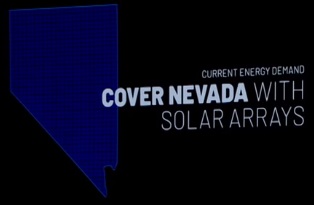
It looks complicated, but possible. In any case, it is generally a desert. But after only 200 years, taking into account a 3% increase in energy consumption, we will need to cover all the land on Earth with solar panels.

This will not happen, as this is a very impractical solution. You can be sure that this will not work. What can we do?
For starters, you can focus on efficiency. This is a good idea. But the problem is that this has already been done. Throughout the history of mankind, that growth of 3% was achieved mainly due to increased efficiency. Let me give you some examples.
200 years ago, you would have had to work 84 hours to get 1 hour of artificial light. Today it will take 1.5 seconds. We went all the way from candles, through kerosene and incandescent bulbs to LEDs, and got tremendous efficiency. Another example is transport. Air Transport. For 50 years, commercial aviation has shown fourfold efficiency.

In terms of per person, 412 liters of fuel were consumed to cross the country. (fuel per flight, calculated per person. Flight Los Angeles - New York.) Today, on a modern Boeing 787, it will take 90 liters. Incredible achievement.
What about computer computing? They have become a trillion times more effective.

The UNIVAC I computer [the first commercial computer created in the United States] performed 15 computations at one kilowatt per second. Today's processor is capable of performing 17 trillion calculations with the same consumption.
What happens when things become more efficient. We use them more often. Light has become extremely accessible, and therefore has become ubiquitous. Aircraft have become more economical, and therefore have become ubiquitous. Computer computing has become cheaper, so we have snapchat.
Demand for energy is growing steadily. We will become even more efficient, but even then our demand for energy will increase. A significant increase in efficiency has already been included in this 3% growth rate. What happens when endless hunger meets limited resources. The answer is incredibly simple. Rationing of resources. This is the way we can be. And this is the way on which for the first time your grandchildren and grandchildren of your grandchildren will live worse than you. This is a bad way. But there is good news. It lies in the fact that if we look at the solar system from a practical perspective, we will find infinite resources.
So, we have a choice. We want stagnation and rationing of resources, or we want dynamics and growth. This is an easy choice. We know what we want. It remains to do business. If we enter the solar system, we will be able to get a trillion people, including thousands of Mozart and thousands of Einsteins. It will be an incredible civilization.
What would she look like? How would a trillion people live? It is interesting. Someone named Jerry O'Neill, a professor of physics, looked at this thought very carefully, and asked a very sensitive question that no one had asked before. But is the planet’s surface the best place where humanity will conquer the solar system? He and his students worked on this issue. They came up with an amazing and non-obvious answer - no. Why not? They faced a number of problems. The surface of other planets is not so big. We can talk about doubling at best. Not so much. They are far away. Flight to Mars and back will take a year. A window for flying to Mars opens every 22 months, which is a big problem for logistics. And finally, you are very far away, which makes it impossible for a real-time connection between Earth and Mars. Communication will be limited by the speed of light. Well, of course, you, the children in the forefront, and probably some of the adults, will not even think about playing Fortnight with anyone on Earth. This will not work.
The main problem. Neither Mars nor the Moon can and cannot have gravity like earthly gravity. We will always be in the gravitational field 1/3 of the Earth, in the case of Mars.
So, instead, O'Neill and his students came up with the idea of “Man-made worlds” spinning to create artificial gravity through centrifugal force.

This is a very large structure measured in kilometers, and capable of supporting the lives of a million people or more. Here is the International Space Station for scale. This is a very unusual type of space settlement. Let's see how it could look inside. High-speed transport, agricultural land, we added a small drone here, the city in the background. Some may be entertaining. They do not have to have Earth's gravity. You can create a world of entertainment with zero gravity, so you can fly with your own wings. Some may become some kind of national parks.
It is, in fact, a wonderful place to live there. Some of O'Neill's colonies may become replicas of earthly cities. In some way, the historical centers of cities can be reproduced. It will be a completely new type of architecture. Inside there will be an ideal climate, clear weather. Like the best laziness in the Hawaiian islands, but only all year long. No rains, no storms, no earthquakes. What would buildings look like if they did not have to lay a margin of safety against all these weather phenomena. You will find out. But they are beautiful. People want to live here. And they can be close to Earth, so they can return. And this is important, since people need the opportunity to return to Earth. They do not want to leave Earth forever.
It will also be very easy to move between these O'Neill colonies. The energy spent on visiting friends, family, parks will require very little. And it will be fast. During the day.
This is a very interesting video that I am going to show. This is Professor O'Neill, the man who, with his students, developed a concept called the O'Neill Colony and one of the most popular science fiction writers, Isaac Asimov gives interviews about these colonies. And they ask Azimov a very good question: “Has anyone previously described a similar concept in science fiction, and if not, then why?” And he found a good answer. Take a look.
Could anyone have anticipated a similar idea in science fiction? In fact, no one could, because we are all planetary chauvinists. We all believe that people should live on the surface of the planet, some kind of world. I described colonies on the moon, like hundreds of other science fiction writers. The closest I got to such an idea of "Man-made worlds" in the vastness of space, when I admitted that we get out to the asteroid belt, empty the asteroids, making space ships out of them. It never occurred to me to bring the minerals of an asteroid to Earth, where the conditions are more favorable and to create worlds there.
Since we are going into space to build O'Neill's colonies, what will become of the Earth? It will become a place for government meetings and light industry. It will be a great place for living, tourism, education and some kind of light industry. But a heavy and harmful industry that is dangerous for the population will work outside the Earth.
We need everything at once. We will seize the opportunity to preserve this unique diamond in the form of our planet, which is irreplaceable. There is no fallback. We will save the planet, and we will not take away from our future grandchildren, and the grandchildren of their grandchildren, their opportunities for dynamic growth. We need everything at once.
Well, who will do this? Not me. And you, the children in the front row. And your children too. Such long-term prospects will take a lot of time. And what you do is create the industry. In the future there will be thousands of companies embodying this project. A whole ecosystem of creator entrepreneurs with ideas on how to interact with space. But the companies that I'm talking about cannot exist today. It's impossible. And the reason is that conducting any interesting space projects is very expensive. That's because there is no infrastructure.
I'll tell you a story about Amazon. In the 94th year, I founded Amazon. All the necessary infrastructure for this was already. We did not need to build a transport system for the delivery of parcels. She already was. If we started building it, it would require billions of dollars of capital. But she already was. It was called the US Postal Service, and the Deutsche Post, and Royal Mail, and UPS, and FedEx. There was an opportunity to develop thanks to this infrastructure.
Same thing with the payment system. We had to invent it and deploy it, which would cost us billions of dollars in decades of implementation. But it already was called a credit card. Should I introduce a computer everywhere? No, they were already in many houses. Mostly for games, of course, but they were. The necessary infrastructure was already there. Developing a telecommunications network would also take billions of dollars. This was done by those who built the network of international calls, it was built by operators like AT&T and its analogues around the world.
The infrastructure allows entrepreneurs to do amazing things.
So, the guys here and your children, your grandchildren. You will build O'Neill's colony. The task of this generation, my generation is to create the infrastructure for your capabilities. We are going to pave the way into space. And then amazing things will happen, then you will see an entrepreneurial miracle, then you will see how space companies will be created from scratch. Now this is impossible.
And how do we actually build O'Neill's colonies? No one knows. I dont know. And none of those here too. It is a challenge for future generations to figure out the details. There are a certain number of possibilities that we can choose from. Some prerequisites, harbingers. If we do not follow them, nothing will come of it. And it's cool to be aware of these prerequisites, because you can work with them. There is a high probability that they can be useful. Regardless of how the idea of the O'Neill colonies develops, these things matter. What are these premises?
First: a major reduction in the cost of space travel. They are just very ROAD today. And the second: the use of extraterrestrial resources. The earth has a very powerful gravitational field. And to lift all the resources there into space is very expensive. We need to learn how to use the resources available to space. Here.
This is a New Shepard rocket. She and our team have made amazing progress in achieving rocket reusability. I am incredibly proud of the work that the team has done. We have 10 successful returns in a row, 5 for each version of the stage, with almost no after-flight service. Here's how you lower your startup cost.
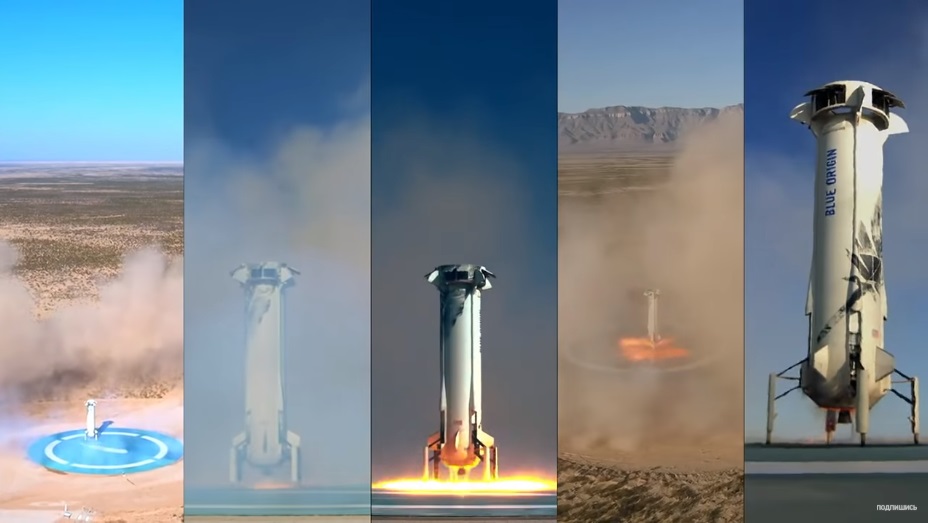
Reusable rocket use. Today, a rocket is used once and thrown away. In addition, if the above after-flight service is expensive, then this is fake reusability. People will fly to New Shepherd this year. This is incredibly exciting.
I want to talk about some design decisions that we came to when creating New Shepard. This rocket is a suborbital designed for space tourism. And for this project, we made some very interesting technological solutions.
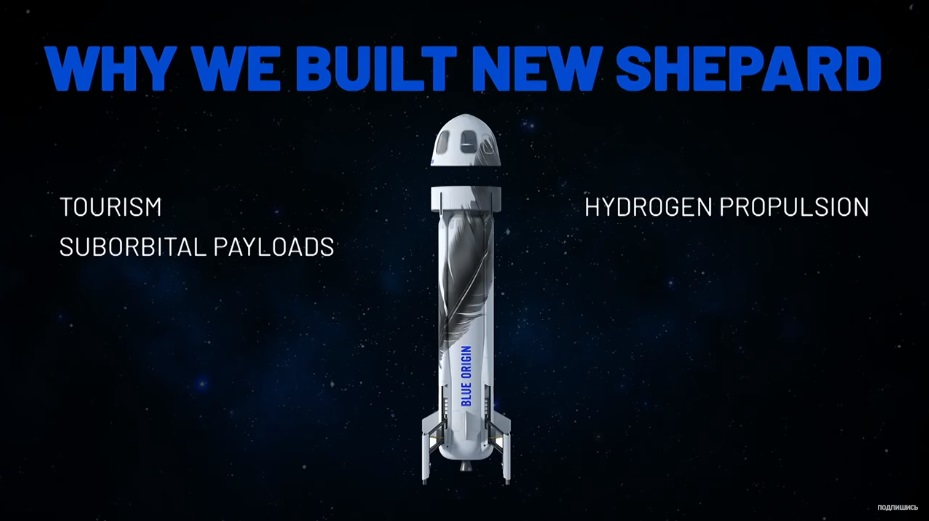
First, New Shepard flies on liquid hydrogen. This is the most powerful rocket fuel. But at the same time it is the most difficult to operate, and it is not so necessary for suborbital flights. So why did we choose him? Because it will be needed at the next stage, we wanted to get the necessary practical knowledge of working with this powerful fuel.
Something about a vertical landing. Why did we choose a vertical landing for this rocket? The choice in the direction of vertical landing may seem unobvious for such a small rocket. In fact, vertical landing is easier to use in a large rocket.
Vertical rocket landing is like balancing a broom on a finger. You can balance the broom, but try to hold the pencil this way. It is defiantly complicated. The moment of inertia of the pencil is too small. So, the great news about the vertical landing is that it scales very well. More rocket - easier landing.
From the very beginning, we wanted to build a human-oriented system. So we had to think very carefully about safety, reliability, rescue systems. All items
which we know that we need, are being developed to create the next generation rocket.
So the whole point is in experience. I can’t wait to see the first first manned flight on
New Shepard. This is a big event. Thank.
Let's talk about the New Glen.

New Glen is New Shepard's older brother. This missile is so large that the New Shepard missile itself would fit under the fairing of the missile. She develops 3.9 million pounds of traction. It is very big. I ask a very interesting question from time to time. I like him, and I like to think about him. Jeff, what will change in the next 10 years. This is a good topic for breakfast. But there is an even more important question that I almost never asked - “What will not change over the next 10 years?”. And the essence of this issue is important, because you can make plans for this time. For Amazon, I know that customers want lower prices. It will not happen. Customers want faster delivery and more choices. So, the energy directed at these things will continue to pay dividends. It is impossible to imagine that a client came to me in 10 years and said: “Jeff, I adore Amazon. I just want delivery to be slower. ”Or“ I love Amazon, but can I raise the prices a little? ” It will not happen. So when you can understand what things do not change under any circumstances, you can invest.
We know these things for New Glenn. This is cost, reliability and focus on startup time. And now all these things need to be worked out before we move further into the solar system. I know these things are unshakable. There will be no such thing that after 10 years a client will come to us and say, “Jeff, I want the rocket to fall more often. Jeff, I would like the rocket to be more expensive ... "or" ... you would be late for the launch date. " So by the way, the modern availability of launch in space is really a big problem in the industry, and most people far from this industry underestimate it. This really interferes and from that the cost per kg of payload rises. These things are unchanging, and therefore we invest in them.
All rockets will be designed on these principles.
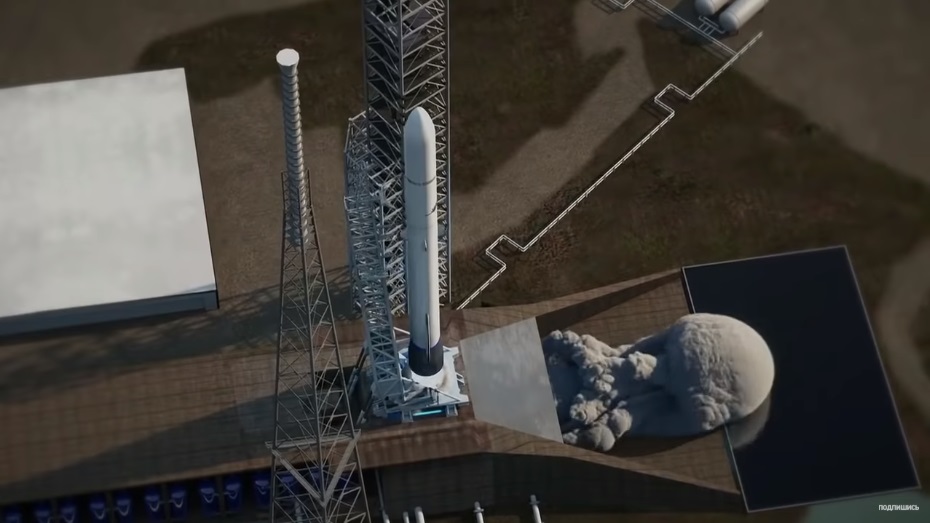
This video will show you a little how New Glenn will look. It can be seen that the flame is blue, as it is created by liquefied natural gas, very cheap. 3.9 million pounds of traction. These large stabilizers at the bottom of the steps will help her sit on the platform correctly when landing. We see the separation with the second stage, on which there are two BE-3U engines. This is the same engine that is now on the New Shepard rocket, with the same liquid hydrogen fuel, though slightly modified for the upper stage. So we deliver the payload. And the first step, designed to be used 25 times. It allows you to put a fairing with a diameter of as much as 7 meters. And this is important, since many cargoes are now limited not so much in mass as in volume. This is a huge rocket, and it will be able to send up to 45 tons to low Earth orbit and 13 tons to geo-transition.

Here we see the landing on the ship. The ship on the move when the step sits down. Why is that? Because we design a rocket unpretentious to weather conditions. We design such a system so that it is able to operate under the same conditions as Orlando Airport. And we cannot tell our customers: “Today is a good day at Cape Canaveral, but, unfortunately, there are high waves at the landing site of the first stage.” So with the ship on the go, we can use the keels to stabilize the landing platform and interact with the stage at very high waves. And also from the very beginning it will be designed for manned flights. We will fly in 2021 for the first time.
Reusability is definitely the key to drastically lower flight prices. People sometimes think about how expensive fuel is. Is there a problem with the fuel? Liquefied natural gas is very cheap. Even if we take the millions of pounds of fuel that the New Glenn rocket needs, the cost of this fuel for New Glenn, the fuel and oxidizer, will not exceed a million dollars. This is an insignificant expense item in the whole scheme.
The reason why launching into orbit is so expensive today is because you throw away all the iron in vain. It's like going to the store by car and throwing it away after one trip. This would make shopping trips very expensive.
The second limit that I know, we must overcome. I am sure of that. Space resources. We must use them. And we have a gift. We were given a gift. A gift within walking distance called the Moon. We know a lot about the Moon now, which we did not know during the Apollo mission, or even at least 20 years ago. One of the most important things we know about the moon today is that there is water. Enclosed in the form of ice, it is in constant shadow in craters at the poles of the moon. And water is an incredibly valuable resource.
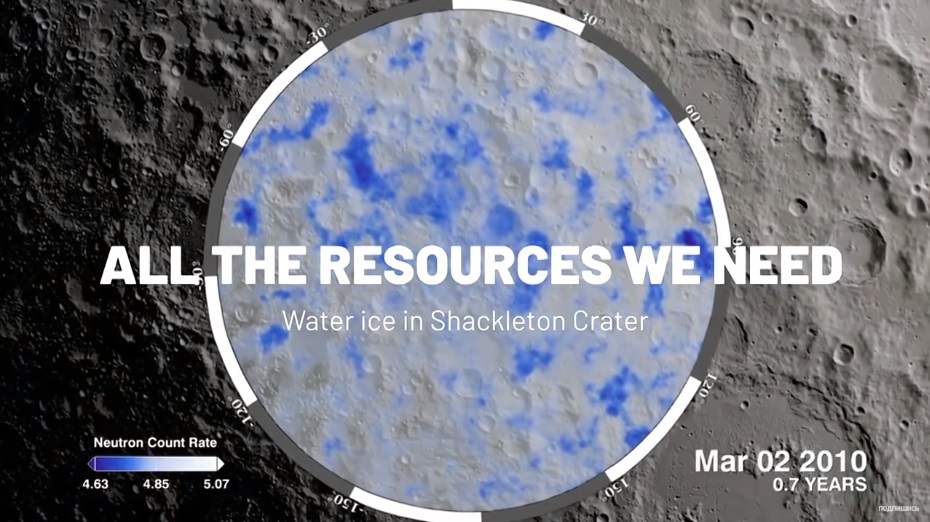
You can use electrolysis to break down water into hydrogen and oxygen, and now you already have fuel components.
Another cool reason why the moon can be considered a gift is that it is close. Just three days flight. And you do not need to adapt to the launch window, for example, once every 22 months with Mars. You can fly to the moon whenever you want.
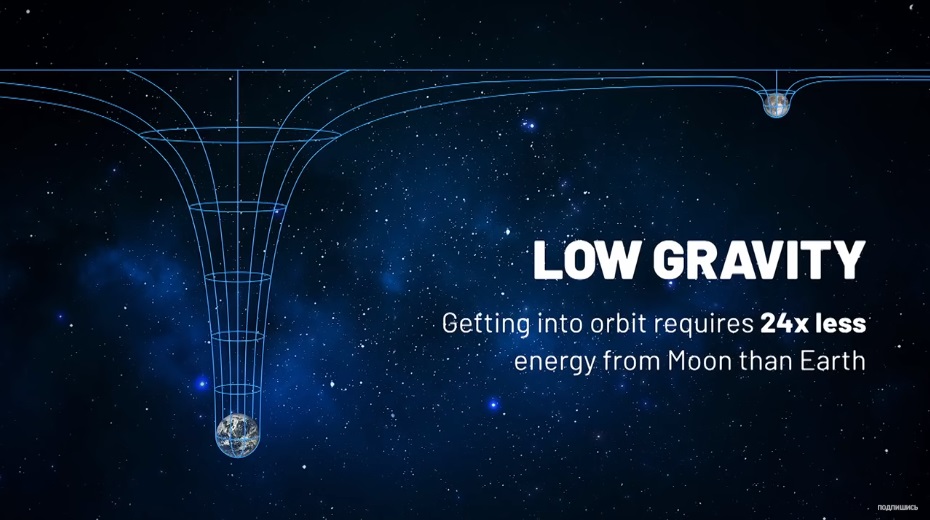
And one important point associated with the construction of huge objects in space - the Moon has 6 times less gravity than the Earth. When you need to send cargo from the surface of the moon into space, you need 24 times less energy than if you lifted the same load from Earth. This is a huge advantage.
But you know what?The moon also needs infrastructure. I'll show you something.

This is Blue Moon. We have been working on this device for the past 3 years.
This is a very large descent vehicle that can gently and accurately place 3.6 tons of cargo onto the lunar surface. In the version with an increased fuel tank, he will be able to land 6.5 tons on the moon.
Let me give you a tour.
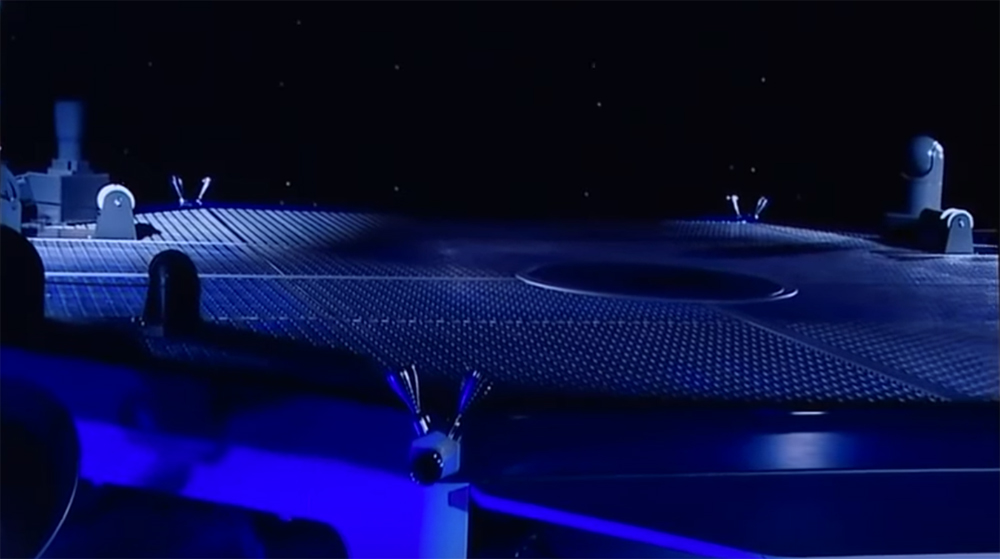
The roof is designed so that it is very easy to interact with. Therefore, it is safe and has a wide range of options for attaching the payload to the roof.
The lift you see here was inspired by marine engineering. It will be used to unload cargo from the roof to the surface of the moon and can be modified to meet the requirements of the launched cargo.
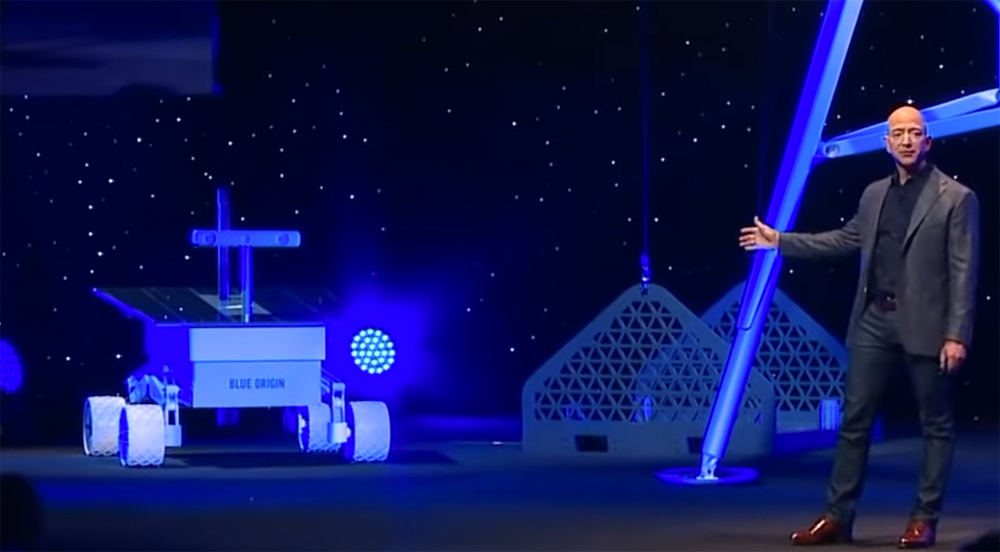
Here we have an example of a very large moon rover, and to everything else, even taking into account its size, Blue Moon will be able to bring 4 of them at the same time.
And if we go back to the roof again, I will show you a few more things. On the left side of the device you will see our star sensor. With it, Blue Moon will be able to navigate independently in space. And on the right side is an optical communication system that will provide gigabit bandwidth between the Earth and the Moon. This is a laser that transmits data back to Earth. There is also a communication system in the radio range of 10 megabits.
We continue the tour. Liquid hydrogen Why do we use liquid hydrogen? Apollo’s missions were different. Why do we use liquid hydrogen as fuel? There are several reasons. First: very high power. And it is very handy when you land on the moon. After all, in addition to the apparatus, you need to carry all the fuel on the moon.
The second reason for using liquid hydrogen is that ultimately we want to use hydrogen from the water extracted on the moon and refuel this apparatus for reuse. So liquid hydrogen is an excellent choice for the moon. And for him there are three different applications on this device, which is quite entertaining. Liquid hydrogen as an engine fuel, which will allow you to go down to the surface.
But we also use the process of boiling hydrogen. When liquid hydrogen in a fuel tank begins to boil, its heat penetrates through the walls of the tank to liquid oxygen. And since the boiling point of oxygen is much higher than that of hydrogen, we thereby cool the oxygen, and prevent the boiling of oxygen. So this is the second use of hydrogen.
After cooling the oxygen, hydrogen enters the battery to power the hydrogen fuel cells. We chose hydrogen fuel cells for this device instead of solar panels, because we want to be able to work on a moonlit night, which is impossible with solar panels. A moonlit night lasts two weeks, which are very cold. In addition, fuel cells generate a lot of energy. They produce 2.5 kilowatts of energy, which is only possible with a very large solar panel.
Landing legs have a folding mechanism, so they can fit under a 7-meter fairing, and in the process they are moved apart. They are designed to have a very wide angle. Therefore, landing on a lunar hill with a slope of 15 degrees is possible, and this is a large slope. It will be safe.
You will not see him, since he is at the bottom, but the device has a flashlight.
So that we can map the terrain hidden in the shade.
There is no GPS on the moon. So, if you want to land accurately ... we can land with an accuracy of 20-25 meters from the target ... when you want to land precisely - you can use the local landscape for navigation. Now we have a high quality map of the entire moon. We can use these existing maps to tell the device ... there is a machine learning system on board ... we can tell the device that it needs to look for such an area with such craters and navigate them. Use of local geological formations of the moon as signposts.
This is an incredible device and it will go to the moon. There is one more thing I want to show you. And Marina, you can get up. Thank. That's for me? What is it?This is from our robotics team. Your robotics team. Thank.I'll put it in my pocket. Come on.
Over this difficult, but very interesting task, we fought for 3 years. She needed a solution. Thank you Marina.
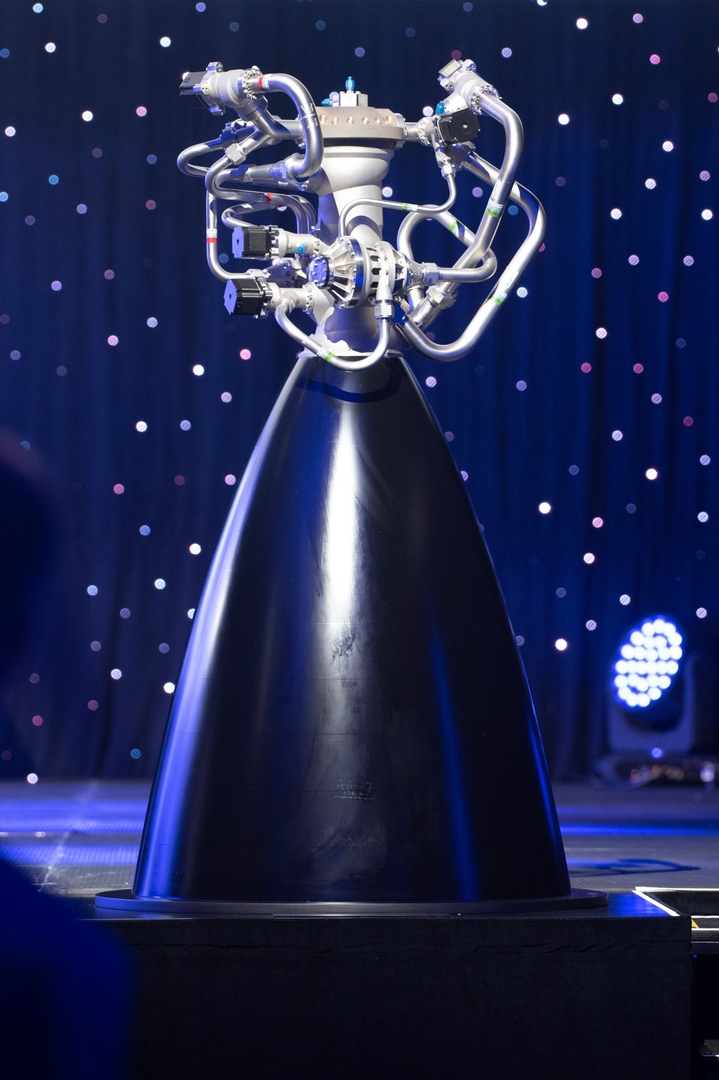
This is a BE-7 engine. It is powered by liquid hydrogen / oxygen. The first burning we expect to carry out this summer. We worked for 3 years for this. Most of the details are printed on the printer. It has 10,000 pounds of traction.

It has very broad capabilities for changing traction. This is critical when landing on the moon. Because when this landing gear is fully charged, its weight is about 15 tons. When he lunches and burns all the fuel - his weight will be about 3 tons. Thus, in order to ensure the correct fit of the device, you should be able to control the engine thrust, as the weight of the device decreases with the burning of fuel.
The tasks in question. We already solved them on the New Shepard rocket. These tasks are very similar. Landing bearings, fuel tanks with liquid hydrogen. All these tasks have already been solved. Even automatic landing and the like. But we need a new engine, and this is it. And this is amazing. The team that has made incredible progress, our jet thrust team - I’m proud of them. Can’t wait to see. 453 seconds of specific thrust. Very powerful engine. I can’t wait for the test.
We will post the video. Bob is laughing. We will lay out. Good.
I want to show you an example of how a mission can go. This is not a cartoon, this is real physics. We have run this simulation for a long time and many times. There are several things to notice. One thing is that the payload of the device can be mounted on the sides. And when the device flies in the orbit of the moon, performing the main mission, it can complete the associated mission. It can launch small satellites in orbits around the moon. So you can do scientific work. Here's how it can happen. So we will launch several satellites before landing. You see the ignition, which will slow down the device and lower it to the surface. The main engine operation will last 6 minutes. That is, the BE-7 will work for 6 minutes. This is a very long job.
Our view covers a height of about a kilometer above the surface. Now you see how this happens. A very accurate landing using the same flashlight to detect the features of the lunar landscape for later comparison with loaded maps.

Now we see how the lift, inspired by analogues from the maritime industry, lowers the rover. Look at these long shadows, they are always so long at the poles of the moon.

Wow. There are a lot of interesting science on the moon. Especially at the poles. And we formed a scientific advisory council, which is here today with us - Dana only for one second to be recognized. Fuck us. Thank.We really appreciate that. The wisdom and advice of this group will help ensure that research is conducted correctly and that we get the most out of the business. Thanks you.
We also already have several clients for Blue Moon, many of whom are here in the audience, they will also conduct scientific missions on the Moon. People are very excited about this opportunity - the soft landing of their cargo, moon rovers, scientific experiments on the surface of the moon with unprecedented accuracy to this day.
Let's think about what you can load onto the roof of this unit. This is an image of a rover that maintains normal pressure. And it’s amusing that when you can land very precisely in the right place, it becomes possible to organize a mission with several successive landings. Thus, you first lower the rover to the surface using the elevator, make sure that the device is working properly, and then send the astronauts. And speaking of sending astronauts, this is a version with an increased fuel tank, larger than what is behind me. This is an extended version of the “Blue Moon”, which can gently plant 6.5 tons on the surface of the moon, for example, a take-off module.
I want to show you one small thing, which, I think, looks funny, namely landing supports. Here, you see here these legs at the support. When I first saw their drawings a long time ago, and my idea of landing paws was formed on the basis of devices from the Apollo mission ... I was sure that they were too small, and I asked about them. And they answered me that it’s not they who are too small, but those that are too big on Apollo. Because at that time they were very worried that the lunar surface could be very soft.
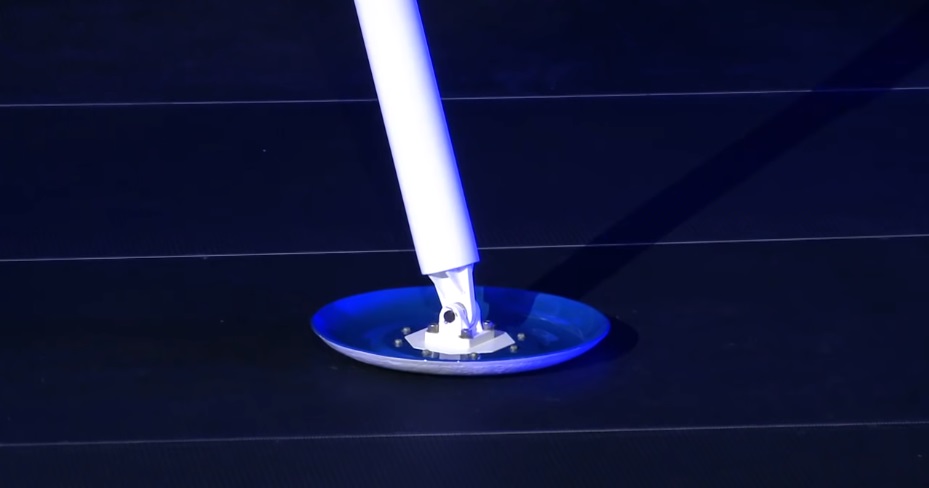
This is just an example of how much we know today, so these legs are normal, do not worry.
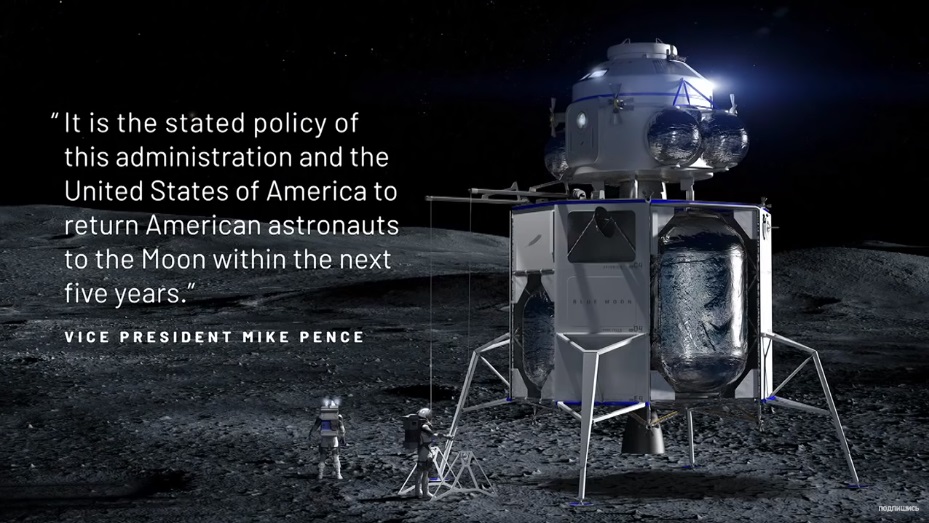
Vice President Pence recently said: “The official policy of the current administration and the United States of America is to return American astronauts to the moon over the next five years.”
I'm crazy about it. That’s just the way it is. And through simple arithmetic operations, we can understand that it will be 2024. And we can help comply with this schedule, but only because we started three years ago. It's time to return to the moon to stay.
Those ideas that I spoke about today are obviously intergenerational. This will not be done by any one generation.
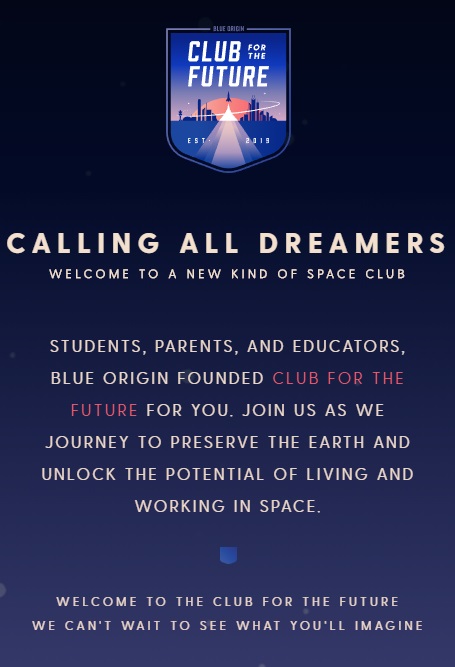
And one of the things we have to do is inspire future generations. And therefore, today I announce that Blue Origin is establishing the Future Club, whose mission is to inspire young people to pave the way to the future, where people will live in space. You see children in the forefront - these are the first founding members of the Future Club. Thank you guys.
And we are going to hold a series of events for children from preparatory classes to graduations. And first ... of which I am delighted ... we just ask the children to send us cards with their dreams for the future. And then we will send them into space, and New Shepard will return them, and we will mail them back. And today I had the opportunity to meet with this group of children, right before the presentation. I arrived there for about three hours for while they were making their cards. And they are awesome. I saw some amazing ones.
I really liked the card that one girl addressed to the boy at school, whom she fell in love with, and my mother does not know yet. But I suppose she understands that everything is in order. By the time we send the postcard into space and then send it to the recipients, everything will probably be all right, my mother will know everything by that time. This is awesome.
So there’s a lot ... among other things, ... if ... I’ve talked with these children before, those in the front row ... if they are an example of what the next generation will be like, we will be fine. Teachers who want to participate in this, just come to clubforfuture.org, there are all the necessary instructions.
Please understand me correctly. Earth is the best planet. She is not covered by anything. We really need to protect her. This is important, this is our work, we are now large enough to harm this planet. We must use space resources, we must have a future for our grandchildren, and their grandson, which is expressed in dynamic growth. We cannot allow them to become victims of stagnation and rationing of resources. And the task of this generation is to build a road into space so that future generations can reveal their creative potential. When it’s possible with the infrastructure, just like it was for me in '94, when we launched Amazon, when we have such infrastructure for future space entrepreneurs, you will see that amazing things are happening and they will happen quickly. I guarantee it.People are so creative when free.
And we, our generation will pave the way to space, create this infrastructure. We will see thousands of future entrepreneurs creating a real space industry. And I want to inspire these future space entrepreneurs. So think about the following. Although such prospects sound very large-scale, they are. There is nothing simple, everything is complicated. But I want to inspire you, so consider the following. Big things start small.
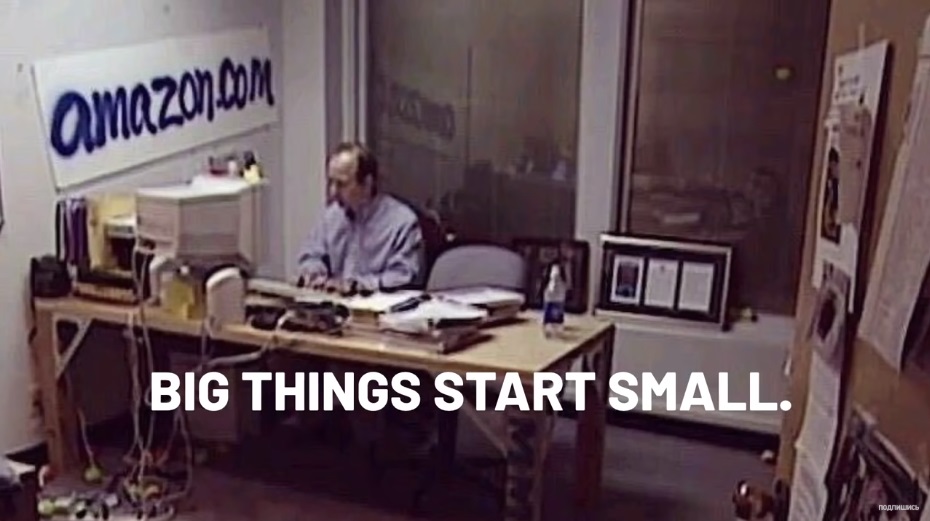
Thank.
Translation: Rafael Feiskhanov
We, too, are preparing the younger generations a bit to create cool things from the future:

We are launching a DIY course “Make Your Jetpack” for schoolchildren and students.

So if you have any signs of rugged padawans or the desire to turn nuts or mentor young ones by yourself, contact us.
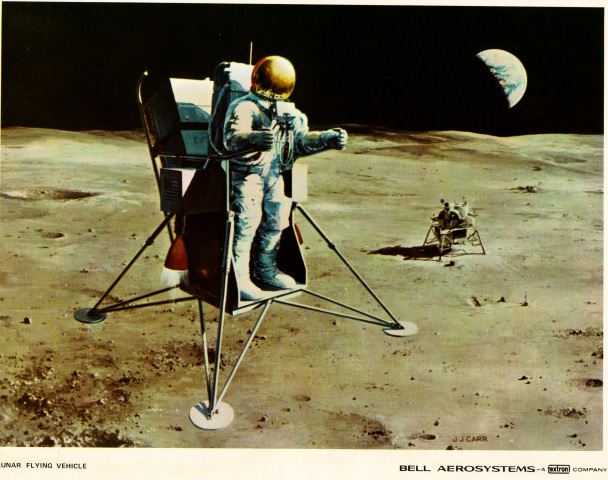
On the moon, this will be an excellent means of increasing the mobility of selenites.
In the first part, Jeff Bezos talks about his childhood dreams about space and about his way of thinking about the future (a planning horizon of more than 200 years, energy depletion, starting small, doing things not for immediate benefits, but for the future, projects for several generations ahead, etc. ), in the second part - about his lunar project. In the end, Jeff passes the baton to the younger generation. Enjoy watching.
Decoding:
20 seconds to start.
15 seconds to start.
Transition to autonomous control.
Twelve.
Eleven.
Ten.
Nine.
I start the ignition.
Six.
Five.
Four.
Three.
Two.
One.
Zero.
All engines are working in order.
Climb.
Rise of Apollo 11.
The service tower is normal.
Neil Armstrong reports from the Sea of Peace.
We will read the plate that is on the landing gear support. Hemispheres come first, each showing the hemisphere of the Earth. It is written below: “Here Man from planet Earth first set foot on the moon, July 1969 A.D. We have come in peace for all of humanity. ”
Oh cool. Is lighting half decent?
Good, they also got a flag, and now on the surface of the moon you can see stars and stripes.
Wow!
If this does not inspire you, you have come here in vain. You do not choose a dream. This dream is choosing you. When I was 5, I saw what you just watched. And it had a huge impact on me, which has not changed over time.

This is me in high school. And I want to pay attention to this quote.

“Earth is not infinite, and if the world economy and population continues to grow, then space will remain the only way for movement.”
I still believe in it. By the way, this is my version of wasted youth. Guess which planet is the best in the solar system? This question is easy to answer. We launched research vehicles, such as this one, to all corners of the solar system. Some of them just flew past the planets, but examined them all. Earth is the best planet. It is not close. She is really good. Don't even start talking about Venus. Look at the earth. She is incredible. Jim Lovell, one of my heroes. During the Apollo 8 mission, when he circled the moon, he did something amazing.

He raised his thumb, and realized that with his thumb he could close the whole Earth. All that he knew could be covered with a finger and he said something amazing. “People often say,“ I hope to go to heaven after death. ” He said, "At that moment, I realized that I went to heaven when I was born." Earth is heaven.

Karl Sagan, spoke poetically. “At this blue dot, everything you have ever known, and everything you've ever heard of. And all the people who have ever lived have lived their lives here. This is a very small platform in a vast space arena. ”
Throughout the history of mankind, the Earth has been felt more than us. And in fact, this is a pretty true feeling. She must be big. Humanity must be small. But the reality is now different. The earth has ceased to be big. Humanity has become too great.
The planet seems big, but it is not infinite. And there is something we need to do. It is necessary to realize that there are urgent problems; things to work on and we are working on them. We are talking about poverty, hunger, the homeless, the environment, the depletion of the ocean. There is a large list of problems of urgent problems and we need to work on these things urgently, here and now.
But, there are also long-term problems. And you need to work on them too. And their decision will take more time. You cannot wait for long-term problems to become urgent. We can do both. We can work here and now and we can work on solving long-term problems.
The main long-term problem is the energy depletion of the Earth. Even purely arithmetic - it will happen.

As an animal, a person consumes 97 watts of energy. This is our metabolism as a biological being.

But as residents of the civilized world, we consume 10,000 watts per person. And we have a lot of benefit from this. We live in an era of dynamic growth. Your grandparents have better living conditions. And they lived better than their grandparents. And a significant reason for this is the abundance of energy that we are able to receive and use with benefit.
When we use energy, a lot of good things happen. When you are in the hospital, we use a lot of energy. All medical equipment was created for you at the enterprises. Transport. Different types of entertainment that bring us joy. The medicines that we use. All these things require a large amount of energy, which we do not stop using. But this thing is unstable. Here is what we have.

The rate of energy consumption in human history is growing at 3 percent every year. 3% does not sound very impressive. But over a long time span, 3% show extreme growth. This means doubling energy needs every 25 years. For example, to cover today's energy needs of humanity, it is enough for us to cover the state of Nevada with solar panels.

It looks complicated, but possible. In any case, it is generally a desert. But after only 200 years, taking into account a 3% increase in energy consumption, we will need to cover all the land on Earth with solar panels.

This will not happen, as this is a very impractical solution. You can be sure that this will not work. What can we do?
For starters, you can focus on efficiency. This is a good idea. But the problem is that this has already been done. Throughout the history of mankind, that growth of 3% was achieved mainly due to increased efficiency. Let me give you some examples.
200 years ago, you would have had to work 84 hours to get 1 hour of artificial light. Today it will take 1.5 seconds. We went all the way from candles, through kerosene and incandescent bulbs to LEDs, and got tremendous efficiency. Another example is transport. Air Transport. For 50 years, commercial aviation has shown fourfold efficiency.

In terms of per person, 412 liters of fuel were consumed to cross the country. (fuel per flight, calculated per person. Flight Los Angeles - New York.) Today, on a modern Boeing 787, it will take 90 liters. Incredible achievement.
What about computer computing? They have become a trillion times more effective.

The UNIVAC I computer [the first commercial computer created in the United States] performed 15 computations at one kilowatt per second. Today's processor is capable of performing 17 trillion calculations with the same consumption.
What happens when things become more efficient. We use them more often. Light has become extremely accessible, and therefore has become ubiquitous. Aircraft have become more economical, and therefore have become ubiquitous. Computer computing has become cheaper, so we have snapchat.
Demand for energy is growing steadily. We will become even more efficient, but even then our demand for energy will increase. A significant increase in efficiency has already been included in this 3% growth rate. What happens when endless hunger meets limited resources. The answer is incredibly simple. Rationing of resources. This is the way we can be. And this is the way on which for the first time your grandchildren and grandchildren of your grandchildren will live worse than you. This is a bad way. But there is good news. It lies in the fact that if we look at the solar system from a practical perspective, we will find infinite resources.
So, we have a choice. We want stagnation and rationing of resources, or we want dynamics and growth. This is an easy choice. We know what we want. It remains to do business. If we enter the solar system, we will be able to get a trillion people, including thousands of Mozart and thousands of Einsteins. It will be an incredible civilization.
What would she look like? How would a trillion people live? It is interesting. Someone named Jerry O'Neill, a professor of physics, looked at this thought very carefully, and asked a very sensitive question that no one had asked before. But is the planet’s surface the best place where humanity will conquer the solar system? He and his students worked on this issue. They came up with an amazing and non-obvious answer - no. Why not? They faced a number of problems. The surface of other planets is not so big. We can talk about doubling at best. Not so much. They are far away. Flight to Mars and back will take a year. A window for flying to Mars opens every 22 months, which is a big problem for logistics. And finally, you are very far away, which makes it impossible for a real-time connection between Earth and Mars. Communication will be limited by the speed of light. Well, of course, you, the children in the forefront, and probably some of the adults, will not even think about playing Fortnight with anyone on Earth. This will not work.
The main problem. Neither Mars nor the Moon can and cannot have gravity like earthly gravity. We will always be in the gravitational field 1/3 of the Earth, in the case of Mars.
So, instead, O'Neill and his students came up with the idea of “Man-made worlds” spinning to create artificial gravity through centrifugal force.

This is a very large structure measured in kilometers, and capable of supporting the lives of a million people or more. Here is the International Space Station for scale. This is a very unusual type of space settlement. Let's see how it could look inside. High-speed transport, agricultural land, we added a small drone here, the city in the background. Some may be entertaining. They do not have to have Earth's gravity. You can create a world of entertainment with zero gravity, so you can fly with your own wings. Some may become some kind of national parks.
It is, in fact, a wonderful place to live there. Some of O'Neill's colonies may become replicas of earthly cities. In some way, the historical centers of cities can be reproduced. It will be a completely new type of architecture. Inside there will be an ideal climate, clear weather. Like the best laziness in the Hawaiian islands, but only all year long. No rains, no storms, no earthquakes. What would buildings look like if they did not have to lay a margin of safety against all these weather phenomena. You will find out. But they are beautiful. People want to live here. And they can be close to Earth, so they can return. And this is important, since people need the opportunity to return to Earth. They do not want to leave Earth forever.
It will also be very easy to move between these O'Neill colonies. The energy spent on visiting friends, family, parks will require very little. And it will be fast. During the day.
This is a very interesting video that I am going to show. This is Professor O'Neill, the man who, with his students, developed a concept called the O'Neill Colony and one of the most popular science fiction writers, Isaac Asimov gives interviews about these colonies. And they ask Azimov a very good question: “Has anyone previously described a similar concept in science fiction, and if not, then why?” And he found a good answer. Take a look.
Could anyone have anticipated a similar idea in science fiction? In fact, no one could, because we are all planetary chauvinists. We all believe that people should live on the surface of the planet, some kind of world. I described colonies on the moon, like hundreds of other science fiction writers. The closest I got to such an idea of "Man-made worlds" in the vastness of space, when I admitted that we get out to the asteroid belt, empty the asteroids, making space ships out of them. It never occurred to me to bring the minerals of an asteroid to Earth, where the conditions are more favorable and to create worlds there.
Since we are going into space to build O'Neill's colonies, what will become of the Earth? It will become a place for government meetings and light industry. It will be a great place for living, tourism, education and some kind of light industry. But a heavy and harmful industry that is dangerous for the population will work outside the Earth.
We need everything at once. We will seize the opportunity to preserve this unique diamond in the form of our planet, which is irreplaceable. There is no fallback. We will save the planet, and we will not take away from our future grandchildren, and the grandchildren of their grandchildren, their opportunities for dynamic growth. We need everything at once.
Well, who will do this? Not me. And you, the children in the front row. And your children too. Such long-term prospects will take a lot of time. And what you do is create the industry. In the future there will be thousands of companies embodying this project. A whole ecosystem of creator entrepreneurs with ideas on how to interact with space. But the companies that I'm talking about cannot exist today. It's impossible. And the reason is that conducting any interesting space projects is very expensive. That's because there is no infrastructure.
I'll tell you a story about Amazon. In the 94th year, I founded Amazon. All the necessary infrastructure for this was already. We did not need to build a transport system for the delivery of parcels. She already was. If we started building it, it would require billions of dollars of capital. But she already was. It was called the US Postal Service, and the Deutsche Post, and Royal Mail, and UPS, and FedEx. There was an opportunity to develop thanks to this infrastructure.
Same thing with the payment system. We had to invent it and deploy it, which would cost us billions of dollars in decades of implementation. But it already was called a credit card. Should I introduce a computer everywhere? No, they were already in many houses. Mostly for games, of course, but they were. The necessary infrastructure was already there. Developing a telecommunications network would also take billions of dollars. This was done by those who built the network of international calls, it was built by operators like AT&T and its analogues around the world.
The infrastructure allows entrepreneurs to do amazing things.
So, the guys here and your children, your grandchildren. You will build O'Neill's colony. The task of this generation, my generation is to create the infrastructure for your capabilities. We are going to pave the way into space. And then amazing things will happen, then you will see an entrepreneurial miracle, then you will see how space companies will be created from scratch. Now this is impossible.
And how do we actually build O'Neill's colonies? No one knows. I dont know. And none of those here too. It is a challenge for future generations to figure out the details. There are a certain number of possibilities that we can choose from. Some prerequisites, harbingers. If we do not follow them, nothing will come of it. And it's cool to be aware of these prerequisites, because you can work with them. There is a high probability that they can be useful. Regardless of how the idea of the O'Neill colonies develops, these things matter. What are these premises?
First: a major reduction in the cost of space travel. They are just very ROAD today. And the second: the use of extraterrestrial resources. The earth has a very powerful gravitational field. And to lift all the resources there into space is very expensive. We need to learn how to use the resources available to space. Here.
This is a New Shepard rocket. She and our team have made amazing progress in achieving rocket reusability. I am incredibly proud of the work that the team has done. We have 10 successful returns in a row, 5 for each version of the stage, with almost no after-flight service. Here's how you lower your startup cost.

Reusable rocket use. Today, a rocket is used once and thrown away. In addition, if the above after-flight service is expensive, then this is fake reusability. People will fly to New Shepherd this year. This is incredibly exciting.
I want to talk about some design decisions that we came to when creating New Shepard. This rocket is a suborbital designed for space tourism. And for this project, we made some very interesting technological solutions.

First, New Shepard flies on liquid hydrogen. This is the most powerful rocket fuel. But at the same time it is the most difficult to operate, and it is not so necessary for suborbital flights. So why did we choose him? Because it will be needed at the next stage, we wanted to get the necessary practical knowledge of working with this powerful fuel.
Something about a vertical landing. Why did we choose a vertical landing for this rocket? The choice in the direction of vertical landing may seem unobvious for such a small rocket. In fact, vertical landing is easier to use in a large rocket.
Vertical rocket landing is like balancing a broom on a finger. You can balance the broom, but try to hold the pencil this way. It is defiantly complicated. The moment of inertia of the pencil is too small. So, the great news about the vertical landing is that it scales very well. More rocket - easier landing.
From the very beginning, we wanted to build a human-oriented system. So we had to think very carefully about safety, reliability, rescue systems. All items
which we know that we need, are being developed to create the next generation rocket.
So the whole point is in experience. I can’t wait to see the first first manned flight on
New Shepard. This is a big event. Thank.
Let's talk about the New Glen.

New Glen is New Shepard's older brother. This missile is so large that the New Shepard missile itself would fit under the fairing of the missile. She develops 3.9 million pounds of traction. It is very big. I ask a very interesting question from time to time. I like him, and I like to think about him. Jeff, what will change in the next 10 years. This is a good topic for breakfast. But there is an even more important question that I almost never asked - “What will not change over the next 10 years?”. And the essence of this issue is important, because you can make plans for this time. For Amazon, I know that customers want lower prices. It will not happen. Customers want faster delivery and more choices. So, the energy directed at these things will continue to pay dividends. It is impossible to imagine that a client came to me in 10 years and said: “Jeff, I adore Amazon. I just want delivery to be slower. ”Or“ I love Amazon, but can I raise the prices a little? ” It will not happen. So when you can understand what things do not change under any circumstances, you can invest.
We know these things for New Glenn. This is cost, reliability and focus on startup time. And now all these things need to be worked out before we move further into the solar system. I know these things are unshakable. There will be no such thing that after 10 years a client will come to us and say, “Jeff, I want the rocket to fall more often. Jeff, I would like the rocket to be more expensive ... "or" ... you would be late for the launch date. " So by the way, the modern availability of launch in space is really a big problem in the industry, and most people far from this industry underestimate it. This really interferes and from that the cost per kg of payload rises. These things are unchanging, and therefore we invest in them.
All rockets will be designed on these principles.

This video will show you a little how New Glenn will look. It can be seen that the flame is blue, as it is created by liquefied natural gas, very cheap. 3.9 million pounds of traction. These large stabilizers at the bottom of the steps will help her sit on the platform correctly when landing. We see the separation with the second stage, on which there are two BE-3U engines. This is the same engine that is now on the New Shepard rocket, with the same liquid hydrogen fuel, though slightly modified for the upper stage. So we deliver the payload. And the first step, designed to be used 25 times. It allows you to put a fairing with a diameter of as much as 7 meters. And this is important, since many cargoes are now limited not so much in mass as in volume. This is a huge rocket, and it will be able to send up to 45 tons to low Earth orbit and 13 tons to geo-transition.

Here we see the landing on the ship. The ship on the move when the step sits down. Why is that? Because we design a rocket unpretentious to weather conditions. We design such a system so that it is able to operate under the same conditions as Orlando Airport. And we cannot tell our customers: “Today is a good day at Cape Canaveral, but, unfortunately, there are high waves at the landing site of the first stage.” So with the ship on the go, we can use the keels to stabilize the landing platform and interact with the stage at very high waves. And also from the very beginning it will be designed for manned flights. We will fly in 2021 for the first time.
Reusability is definitely the key to drastically lower flight prices. People sometimes think about how expensive fuel is. Is there a problem with the fuel? Liquefied natural gas is very cheap. Even if we take the millions of pounds of fuel that the New Glenn rocket needs, the cost of this fuel for New Glenn, the fuel and oxidizer, will not exceed a million dollars. This is an insignificant expense item in the whole scheme.
The reason why launching into orbit is so expensive today is because you throw away all the iron in vain. It's like going to the store by car and throwing it away after one trip. This would make shopping trips very expensive.
The second limit that I know, we must overcome. I am sure of that. Space resources. We must use them. And we have a gift. We were given a gift. A gift within walking distance called the Moon. We know a lot about the Moon now, which we did not know during the Apollo mission, or even at least 20 years ago. One of the most important things we know about the moon today is that there is water. Enclosed in the form of ice, it is in constant shadow in craters at the poles of the moon. And water is an incredibly valuable resource.

You can use electrolysis to break down water into hydrogen and oxygen, and now you already have fuel components.
Another cool reason why the moon can be considered a gift is that it is close. Just three days flight. And you do not need to adapt to the launch window, for example, once every 22 months with Mars. You can fly to the moon whenever you want.

And one important point associated with the construction of huge objects in space - the Moon has 6 times less gravity than the Earth. When you need to send cargo from the surface of the moon into space, you need 24 times less energy than if you lifted the same load from Earth. This is a huge advantage.
But you know what?The moon also needs infrastructure. I'll show you something.

This is Blue Moon. We have been working on this device for the past 3 years.
This is a very large descent vehicle that can gently and accurately place 3.6 tons of cargo onto the lunar surface. In the version with an increased fuel tank, he will be able to land 6.5 tons on the moon.
Let me give you a tour.

The roof is designed so that it is very easy to interact with. Therefore, it is safe and has a wide range of options for attaching the payload to the roof.
The lift you see here was inspired by marine engineering. It will be used to unload cargo from the roof to the surface of the moon and can be modified to meet the requirements of the launched cargo.

Here we have an example of a very large moon rover, and to everything else, even taking into account its size, Blue Moon will be able to bring 4 of them at the same time.
And if we go back to the roof again, I will show you a few more things. On the left side of the device you will see our star sensor. With it, Blue Moon will be able to navigate independently in space. And on the right side is an optical communication system that will provide gigabit bandwidth between the Earth and the Moon. This is a laser that transmits data back to Earth. There is also a communication system in the radio range of 10 megabits.
We continue the tour. Liquid hydrogen Why do we use liquid hydrogen? Apollo’s missions were different. Why do we use liquid hydrogen as fuel? There are several reasons. First: very high power. And it is very handy when you land on the moon. After all, in addition to the apparatus, you need to carry all the fuel on the moon.
The second reason for using liquid hydrogen is that ultimately we want to use hydrogen from the water extracted on the moon and refuel this apparatus for reuse. So liquid hydrogen is an excellent choice for the moon. And for him there are three different applications on this device, which is quite entertaining. Liquid hydrogen as an engine fuel, which will allow you to go down to the surface.
But we also use the process of boiling hydrogen. When liquid hydrogen in a fuel tank begins to boil, its heat penetrates through the walls of the tank to liquid oxygen. And since the boiling point of oxygen is much higher than that of hydrogen, we thereby cool the oxygen, and prevent the boiling of oxygen. So this is the second use of hydrogen.
After cooling the oxygen, hydrogen enters the battery to power the hydrogen fuel cells. We chose hydrogen fuel cells for this device instead of solar panels, because we want to be able to work on a moonlit night, which is impossible with solar panels. A moonlit night lasts two weeks, which are very cold. In addition, fuel cells generate a lot of energy. They produce 2.5 kilowatts of energy, which is only possible with a very large solar panel.
Landing legs have a folding mechanism, so they can fit under a 7-meter fairing, and in the process they are moved apart. They are designed to have a very wide angle. Therefore, landing on a lunar hill with a slope of 15 degrees is possible, and this is a large slope. It will be safe.
You will not see him, since he is at the bottom, but the device has a flashlight.
So that we can map the terrain hidden in the shade.
There is no GPS on the moon. So, if you want to land accurately ... we can land with an accuracy of 20-25 meters from the target ... when you want to land precisely - you can use the local landscape for navigation. Now we have a high quality map of the entire moon. We can use these existing maps to tell the device ... there is a machine learning system on board ... we can tell the device that it needs to look for such an area with such craters and navigate them. Use of local geological formations of the moon as signposts.
This is an incredible device and it will go to the moon. There is one more thing I want to show you. And Marina, you can get up. Thank. That's for me? What is it?This is from our robotics team. Your robotics team. Thank.I'll put it in my pocket. Come on.
Over this difficult, but very interesting task, we fought for 3 years. She needed a solution. Thank you Marina.

This is a BE-7 engine. It is powered by liquid hydrogen / oxygen. The first burning we expect to carry out this summer. We worked for 3 years for this. Most of the details are printed on the printer. It has 10,000 pounds of traction.

It has very broad capabilities for changing traction. This is critical when landing on the moon. Because when this landing gear is fully charged, its weight is about 15 tons. When he lunches and burns all the fuel - his weight will be about 3 tons. Thus, in order to ensure the correct fit of the device, you should be able to control the engine thrust, as the weight of the device decreases with the burning of fuel.
The tasks in question. We already solved them on the New Shepard rocket. These tasks are very similar. Landing bearings, fuel tanks with liquid hydrogen. All these tasks have already been solved. Even automatic landing and the like. But we need a new engine, and this is it. And this is amazing. The team that has made incredible progress, our jet thrust team - I’m proud of them. Can’t wait to see. 453 seconds of specific thrust. Very powerful engine. I can’t wait for the test.
We will post the video. Bob is laughing. We will lay out. Good.
I want to show you an example of how a mission can go. This is not a cartoon, this is real physics. We have run this simulation for a long time and many times. There are several things to notice. One thing is that the payload of the device can be mounted on the sides. And when the device flies in the orbit of the moon, performing the main mission, it can complete the associated mission. It can launch small satellites in orbits around the moon. So you can do scientific work. Here's how it can happen. So we will launch several satellites before landing. You see the ignition, which will slow down the device and lower it to the surface. The main engine operation will last 6 minutes. That is, the BE-7 will work for 6 minutes. This is a very long job.
Our view covers a height of about a kilometer above the surface. Now you see how this happens. A very accurate landing using the same flashlight to detect the features of the lunar landscape for later comparison with loaded maps.

Now we see how the lift, inspired by analogues from the maritime industry, lowers the rover. Look at these long shadows, they are always so long at the poles of the moon.

Wow. There are a lot of interesting science on the moon. Especially at the poles. And we formed a scientific advisory council, which is here today with us - Dana only for one second to be recognized. Fuck us. Thank.We really appreciate that. The wisdom and advice of this group will help ensure that research is conducted correctly and that we get the most out of the business. Thanks you.
We also already have several clients for Blue Moon, many of whom are here in the audience, they will also conduct scientific missions on the Moon. People are very excited about this opportunity - the soft landing of their cargo, moon rovers, scientific experiments on the surface of the moon with unprecedented accuracy to this day.
Let's think about what you can load onto the roof of this unit. This is an image of a rover that maintains normal pressure. And it’s amusing that when you can land very precisely in the right place, it becomes possible to organize a mission with several successive landings. Thus, you first lower the rover to the surface using the elevator, make sure that the device is working properly, and then send the astronauts. And speaking of sending astronauts, this is a version with an increased fuel tank, larger than what is behind me. This is an extended version of the “Blue Moon”, which can gently plant 6.5 tons on the surface of the moon, for example, a take-off module.
I want to show you one small thing, which, I think, looks funny, namely landing supports. Here, you see here these legs at the support. When I first saw their drawings a long time ago, and my idea of landing paws was formed on the basis of devices from the Apollo mission ... I was sure that they were too small, and I asked about them. And they answered me that it’s not they who are too small, but those that are too big on Apollo. Because at that time they were very worried that the lunar surface could be very soft.

This is just an example of how much we know today, so these legs are normal, do not worry.

Vice President Pence recently said: “The official policy of the current administration and the United States of America is to return American astronauts to the moon over the next five years.”
I'm crazy about it. That’s just the way it is. And through simple arithmetic operations, we can understand that it will be 2024. And we can help comply with this schedule, but only because we started three years ago. It's time to return to the moon to stay.
Those ideas that I spoke about today are obviously intergenerational. This will not be done by any one generation.

And one of the things we have to do is inspire future generations. And therefore, today I announce that Blue Origin is establishing the Future Club, whose mission is to inspire young people to pave the way to the future, where people will live in space. You see children in the forefront - these are the first founding members of the Future Club. Thank you guys.
And we are going to hold a series of events for children from preparatory classes to graduations. And first ... of which I am delighted ... we just ask the children to send us cards with their dreams for the future. And then we will send them into space, and New Shepard will return them, and we will mail them back. And today I had the opportunity to meet with this group of children, right before the presentation. I arrived there for about three hours for while they were making their cards. And they are awesome. I saw some amazing ones.
I really liked the card that one girl addressed to the boy at school, whom she fell in love with, and my mother does not know yet. But I suppose she understands that everything is in order. By the time we send the postcard into space and then send it to the recipients, everything will probably be all right, my mother will know everything by that time. This is awesome.
So there’s a lot ... among other things, ... if ... I’ve talked with these children before, those in the front row ... if they are an example of what the next generation will be like, we will be fine. Teachers who want to participate in this, just come to clubforfuture.org, there are all the necessary instructions.
Please understand me correctly. Earth is the best planet. She is not covered by anything. We really need to protect her. This is important, this is our work, we are now large enough to harm this planet. We must use space resources, we must have a future for our grandchildren, and their grandson, which is expressed in dynamic growth. We cannot allow them to become victims of stagnation and rationing of resources. And the task of this generation is to build a road into space so that future generations can reveal their creative potential. When it’s possible with the infrastructure, just like it was for me in '94, when we launched Amazon, when we have such infrastructure for future space entrepreneurs, you will see that amazing things are happening and they will happen quickly. I guarantee it.People are so creative when free.
And we, our generation will pave the way to space, create this infrastructure. We will see thousands of future entrepreneurs creating a real space industry. And I want to inspire these future space entrepreneurs. So think about the following. Although such prospects sound very large-scale, they are. There is nothing simple, everything is complicated. But I want to inspire you, so consider the following. Big things start small.

Thank.
Translation: Rafael Feiskhanov
PS
We, too, are preparing the younger generations a bit to create cool things from the future:

We are launching a DIY course “Make Your Jetpack” for schoolchildren and students.

So if you have any signs of rugged padawans or the desire to turn nuts or mentor young ones by yourself, contact us.

On the moon, this will be an excellent means of increasing the mobility of selenites.
All Articles